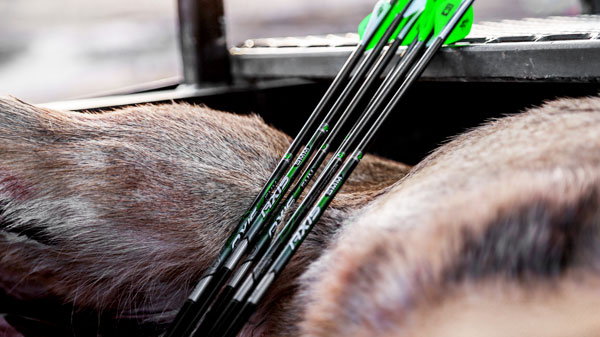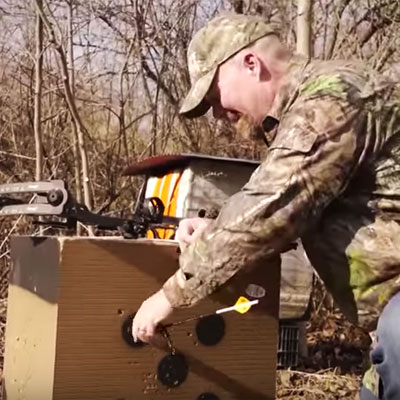As young bowhunters, most of us saw gear ads in the hunting magazines and thought, “Man, if I had that (insert bow, broadhead, arrow, camo, treestand that made you drool), I would OWN that buck!” But time passed, knowledge increased, and we eventually realized that, in bowhunting at least, there are no one-product-wonder shortcuts. Success, instead, is a culmination of quality gear selected with a purpose-driven strategy employed with skilled practice and, ultimately, hard work.
HARD-HITTING TIPS: CHOOSE YOUR NEXT CARBON ARROWS

While adequate equipment performance is obviously essential in our bowhunting endeavors, the confidence equipment can instill in our mental game is equally important when it comes to executing a lethal shot. Knowing that you have high-performing arrows allows your focus to shift toward aiming, releasing and shot placement.
When it comes to crafting the ultimate bowhunting shaft—one that flies true, strikes hard and penetrates deep—the same principles, or essential elements, go a long way toward instilling the confidence needed to make your best shot. There is no one magic arrow out there that does it all, but you can get as close as modern technology allows if you consider these basic ingredients.
Start Small
Forget the “bigger is better” notion in terms of hunting arrows. Rather, consider the expression “good things come in small packages.” Here, we’re talking about small or reduced outside-diameter shafts. To be more precise, small-diameter shafts that also boast above-average wall thickness compared to conventional carbon arrows. Why? Quite simply, the smaller the outside diameter of a hunting shaft the greater the downrange penetration potential of that shaft.
CHECK OUT THE NEW MATCH-GRADE FMJ ARROWS
A smaller shaft presents less surface area as it flies toward the target, which means less atmospheric friction, which translates to greater impact speed and energy for deeper penetration.
Smaller shaft diameters also mean there is less surface area (cross-section) for wind to push against and move the shaft off its trajectory, so accuracy is also a major benefit.
The important thing to remember in our quest for the ultimate hunting shaft is that “small” is not the only key parameter. Weight is important as well.
The conventional carbon shaft conundrum is that, shaft walls being equal, the smaller the shaft diameter the lighter the shaft will be. Given the incredible speeds of modern bows and the lessons learned over the last quarter century regarding the importance of balancing arrow weight and launch velocity to achieve optimal penetration, we don’t necessarily want super light arrows that fly at eye-blistering speeds, because it means sacrificing downrange kinetic energy. What we want are small-diameter arrows that are both fast and deliver a beefy GPI (grains per inch) rating so that all of the awesome bow energy we’re now deploying can translate into a bigger wallop at the target, with pass-through shots and quick kills being the ethical reward. Find small-diameter shafts in the 9-11 GPI range and you’ve got a solid foundation in the quest to build a fast-flying, hard-hitting and deep-penetrating bowhunting arrow.
There are also a couple more benefits to shooting a heavier small-diameter shaft, and those include improved flight stability (especially in windy conditions) greater accuracy and quieter, more efficient bow performance since more of the bow’s energy is transferred to the heavier arrow and not wasted on vibration.
THIN IS IN: SKINNY ARROWS FOR BOWHUNTING
Add Some Heft
Now that we’ve added a heavy, thick-walled, small-diameter shaft to our ultimate bowhunting arrow recipe, what’s next?
More weight.
Ok … this exercise is not ALL about adding weight because balance is important. We want a slim, fast, yet somewhat hefty shaft for the reasons previously mentioned, but we don’t want to pack the weight on willy-nilly because other key areas of arrow flight performance begin to suffer, such as speed (back to downrange kinetic energy) and trajectory (arrow arc or drop). That said, a bit more weight—say, 50-75 grains, depending on your setup—added to the leading end of the shaft can be desirable because it will boost FOC (front-of-center) weight.
FOC weight means arrow weight that is slightly biased toward the front half of the shaft. This is an important consideration for all bowhunters, as an arrow with optimal FOC balance will exhibit good flight stability without seriously impacting trajectory. For bowhunters typically shooting game in the 30-plus-yards range, FOC balance takes on greater importance. Too much forward weight and arrow drop will likely be unacceptable at longer distances. Too little weight and the arrow can become unstable with the slightest gust of wind.
Think of arrow FOC weight the same as you would a lawn dart. The heavily weighted end provides accuracy and stability, but does so at the cost of trajectory. Toss the dart with the weight removed and it’s hard to tell where it will end up landing.
Years of experience in engineering arrow shafts for everyone from bowhunters on up to Olympic archers, has taught the folks at Easton a thing or two about FOC weight. According to Easton, the optimal FOC for a hunting arrow is 10 to 15 percent. You can visit their FOC page for information on calculating your arrow’s FOC weight.
Adjusting FOC weight can be done by adding or removing weight to the front or back of the arrow. Since incremental weight gains are beneficial to our goal of making the fastest-flying, deepest-penetrating hunting arrow, we’ll want to focus on adding weight up front more than removing it from the back.
A quick way to move the needle on FOC is bumping broadhead weight, say, from 100 to 125 grains. That may or may not deliver the 10 to 15 percent FOC balance you’re looking for, in which case a more “adjustable” arrow shaft setup may be in order.
Sound challenging? Not really. Consider Easton’s Axis hunting shafts.
One of the reasons Axis shafts have become so popular among many vertical compound and traditional bowhunters is not only the arrow’s small diameter and thick-wall, high-GPI rating (the desirable features described earlier for a fast, high-penetration hunting arrow), but also their compatibility with Easton’s Brass X HIT (Hidden Insert Technology) Break-Off inserts. These inserts, offered in 6mm and 5mm variants, weigh 75 grains, or can be broken off to weigh 50 grains. The Axis shaft and the modifiable brass insert configuration combines to deliver the ideal blend of arrow diameter, arrow weight and FOC weight needed for maximum downrange penetration, and it does so without sacrificing arrow stability or trajectory when shooting long distances.
It’s almost too easy.
Tune It All Up
Now that we’ve constructed a hunting arrow to deliver the best possible penetration across the ethical bowhunting range, we need to make sure the arrow and broadhead combination is properly tuned to ensure accurate and predictable point-of-impact. Here is where broadhead tuning comes into play.
5 TIPS FOR A DEADLY SILENT HUNTING BOW
The broadhead tuning process is straightforward, with the objective being to get your broadhead-tipped shafts to have the same point-of-impact as when the shafts are tipped with field points. Easton offers a wonderful guide to bow tuning that includes a detailed procedure for tuning broadheads.
Here is the abbreviated version for those shooting conventional compound bows.
- Shoot a three or four arrow group using field points tuned to your bow at 20-30 yards.
- Using the same arrows, install your broadheads and shoot another group.
- If the broadhead group shoots high, raise the nocking point. If the broadheads group low, lower the nocking point. Be sure to make these vertical adjustments before moving on to the lateral (left/right) adjustments.
- Once the elevation tuning is complete, begin adjusting the windage. If the broadhead group shoots left of the field point group, move the arrow rest in toward the riser in small, 1/32-inch increments. If the broadheads shoot right, move the arrow rest away from the riser in 1/32-inch increments.
Other adjustments can be made to your bow/broadhead arrow setup to help achieve these same goals, but for most modern setups, these nock and arrow rest adjustments will do the trick.
And there you have it — the “secret sauce” for getting the most penetration possible in a bowhunting shaft — and maximizing your confidence to make the shot.
— PAID PARTNER CONTENT. This content is brought to you by a D&DH advertising sponsor.

